High-Gain Multi-Band Koch Fractal FSS Antenna for Sub-6 GHz Applications
Abstract
:Featured Application
Abstract
1. Introduction
- First, traditional antenna designs struggle to achieve significant miniaturization without compromising key performance metrics such as the gain, bandwidth, and reflection coefficients. This study employs fractal geometries, specifically Koch curves, to achieve a substantial size reduction while maintaining and even enhancing the performance parameters.
- Effective frequency tuning techniques are lacking in many current antenna designs, but this is crucial for flexible and adaptable 5G applications. This research presents a strong method for frequency tunability by incorporating frequency-selective surfaces (FSS), allowing the antenna to function effectively across many frequency bands. The literature [41,43,46,47,48,49] makes it clear that the FSS size can be maintained at the same level as the antenna. However, there are instances where the FSS size is greater than the antenna size [40,42,50,51]. The antenna’s cost increases with the size, since a larger antenna requires more substrate.
- It is still very difficult to achieve both a large bandwidth and high gain at the same time, especially in smaller antennas. An improved bandwidth and gain are obtained over the intended frequency ranges by means of the suggested design, which optimizes the fractal geometry’s dimensions and its iterative processes for FSS integration. Although SRRs have been proven to improve the antenna properties, the present designs frequently fail to fully leverage their potential. This study shows how SRRs can be used to improve the gain and tunability even in small designs by including SRR loading with reduced ground planes.
- The resonance frequency tuning of most antennas in the literature is not adjusted with the design frequency.
- The antenna’s overall volume is increased by the air gap between the substrates.
2. Materials and Methods
2.1. Principle of Koch Fractal
2.2. Koch Fractal Antenna Patch Development
2.3. Frequency-Selective Surface (FSS) Structure
2.4. Fractal Antenna: Step-by-Step Design Development
2.5. Koch Fractal Antenna with Tunable FSS
2.6. SRR Design at 3.5 GHz
3. Results and Discussion
3.1. Parametric Investigations
3.1.1. Effect of Fractals without Miniaturization
3.1.2. SRR Loading with Reduced Ground
3.1.3. Antenna Miniaturization
3.1.4. FSS Loading for Frequency Tunability and Gain Enhancement
3.1.5. Proposed Antenna with SRR Loading
3.2. Antenna Prototype Model
3.3. Simulated and Measured Reflection Coefficients
3.4. E-Plane and H-Plane Radiation Patterns
3.5. Antenna Gain Plots
3.6. Current Density Distributions
3.7. Comparison with Similar Existing Antennas
4. Conclusions
Author Contributions
Funding
Institutional Review Board Statement
Informed Consent Statement
Data Availability Statement
Acknowledgments
Conflicts of Interest
References
- Werner, D.H.; Ganguly, S. An overview of fractal antenna engineering research. IEEE Antennas Propag. Mag. 2003, 45, 38–57. [Google Scholar] [CrossRef]
- Gianvittorio, J.P.; Rahmat-Samii, Y. Fractal antennas: A novel antenna miniaturization technique, and applications. IEEE Antennas Propag. Mag. 2002, 44, 20–36. [Google Scholar] [CrossRef]
- Nhlengethwa, N.L.; Kumar, P. Fractal microstrip patch antennas for dual-band and triple-band wireless applications. Int. J. Smart Sens. Intell. Syst. 2021, 14, 1–9. [Google Scholar] [CrossRef]
- Werner, D.H.; Haupt, R.L.; Werner, P.L. Fractal antenna engineering: The theory and design of fractal antenna arrays. IEEE Antennas Propag. Mag. 1999, 41, 37–58. [Google Scholar] [CrossRef]
- Nejdi, I.H.; Bri, S.; Marzouk, M.; Ahmad, S.; Rhazi, Y.; Ait Lafkih, M.; Hussein, M. UWB circular fractal antenna with high gain for telecommunication applications. Sensors 2023, 23, 4172. [Google Scholar] [CrossRef]
- Benkhadda, O.; Saih, M.; Ahmad, S.; Al-Gburi, A.J.A.; Zakaria, Z.; Chaji, K.; Reha, A. A miniaturized tri-wideband Sierpinski hexagonal-shaped fractal antenna for wireless communication applications. Fractal Fract. 2023, 7, 115. [Google Scholar] [CrossRef]
- Sediq, H.T.; Nourinia, J.; Ghobadi, C.; Mohammadi, B. A novel shaped ultrawideband fractal antenna for medical purposes. Biomed. Signal Process. Control 2023, 80, 104363. [Google Scholar] [CrossRef]
- Pandav, S.; Sadhukhan, G.; Das, T.K.; Behera, S.K.; Mohanty, M. π-shaped circularly polarized high-gain Minkowski fractal antenna for radar applications. Int. J. Commun. Syst. 2024, 37, e5648. [Google Scholar] [CrossRef]
- Kumar, A.; Dewan, B.; Khandelwal, A.; Shrivastava, K. On the devolvement of fractal antenna for IoT applications. Eng. Res. Express 2023, 5, 035026. [Google Scholar] [CrossRef]
- Kaur, H.; Chawla, P. Design and evaluation of a fractal wearable textile antenna for medical applications. Wirel. Pers. Commun. 2023, 128, 683–699. [Google Scholar] [CrossRef]
- Sabban, A. Novel Meta-Fractal Wearable Sensors and Antennas for Medical, Communication, 5G, and IoT Applications. Fractal Fract. 2024, 8, 100. [Google Scholar] [CrossRef]
- Sran, S.S.; Sivia, J.S. Design of a novel wearable hybrid fractal antenna for Wi-Fi, Bluetooth, and WiMAX applications. Wirel. Pers. Commun. 2023, 132, 737–755. [Google Scholar] [CrossRef]
- Dhara, R.; Govil, M.C.; Kundu, T. Application of theory of characteristics modes for bandwidth enhancement of a miniaturized Minkowski fractal antenna. IETE J. Res. 2023, 69, 5919–5934. [Google Scholar] [CrossRef]
- Varnikha, N.; Jothilakshmi, P. Modified Minkowski Multiband Fractal Antenna for Satellite Applications. Int. J. Microw. Opt. Technol. 2023, 18, 367. [Google Scholar]
- Paun, M.A.; Nichita, M.V.; Paun, V.A.; Paun, V.P. Fifth-generation fractal antenna design based on the Koch Snowflake geometry. A fractal theory application. Expert Syst. 2023, e13242. [Google Scholar] [CrossRef]
- Masroor, I.; Ansari, J.A. An ultrawideband Koch fractal patch antenna. Microelectron. Int. 2024, 41, 109–120. [Google Scholar] [CrossRef]
- Ezhumalai, A.; Ganesan, N.; Palaniappan, R. Koch snowflake fractal embedded octagonal patch antenna with hexagonal split ring for ultra-wide band and 5G applications. Prog. Electromagn. Res. C 2023, 135, 95–106. [Google Scholar] [CrossRef]
- Patel, K.; Behera, S.K. Design of Koch Curve-Based Fractal Antenna for Ultra-Wideband Applications. In Proceedings of the 2023 IEEE Microwaves, Antennas, and Propagation Conference (MAPCON), Ahmedabad, India, 11–14 December 2023; pp. 1–5. [Google Scholar]
- Gupta, M.; Mathur, V. Wheel shaped modified fractal antenna realization for wireless communications. AEU-Int. J. Electron. Commun. 2017, 79, 257–266. [Google Scholar] [CrossRef]
- Benavides, J.B.; Lituma, R.A.; Chasi, P.A.; Guerrero, L.F. A novel modified hexagonal shaped fractal antenna with multi band notch characteristics for UWB applications. In Proceedings of the 2018 IEEE-APS Topical Conference on Antennas and Propagation in Wireless Communications (APWC), Cartagena, Colombia, 10–14 September 2018; pp. 830–833. [Google Scholar]
- Suvarna, K.; Ramamurthy, N.; Vardhan, D. A tri-band miniaturized antenna using fractal defected ground structure for C/X and Ku-band applications. Prog. Electromagn. Res. M 2022, 113, 115–128. [Google Scholar] [CrossRef]
- Yu, Z.; Li, Y.; Lin, Z.; Ran, X. Design of window grille shape-based multiband antenna for mobile terminals. Int. J. Antennas Propag. 2021, 2021, 6684959. [Google Scholar] [CrossRef]
- Gupta, N.; Saxena, J.; Bhatia, K.S. Optimized metamaterial-loaded fractal antenna using modified hybrid BF-PSO algorithm. Neural Comput. Appl. 2020, 32, 7153–7169. [Google Scholar] [CrossRef]
- Kumar, D.; Ahmed, S. Modified ring shaped Sierpinski triangle fractal antenna for C-band and X-band applications. In Proceedings of the 2014 International Conference on Computational Intelligence and Communication Networks, Bhopal, India, 14–16 November 2014; pp. 78–82. [Google Scholar]
- Froumsia, D.; Dikoundou, J.E.; İnç, M.; Houwe, A.; Kolyang, K. Miniaturization and performance studies of rectangular microstrip patch antennae using Minkowski fractal for Ku band communications by inset feed technique. Researchsquare, 2022; Preprint. [Google Scholar]
- Kaur, M.; Sivia, J.S. ANN and FA-based design of hybrid fractal antenna for ISM band applications. Prog. Electromagn. Res. C 2020, 98, 127–140. [Google Scholar] [CrossRef]
- Swetha, A.; Naidu, K.R. Miniaturized antenna using DGS and meander structure for dual-band application. Microw. Opt. Technol. Lett. 2020, 62, 3556–3563. [Google Scholar] [CrossRef]
- Anguera, J.; Andújar, A.; Jayasinghe, J.; Chakravarthy, V.V.S.S.S.; Chowdary, P.S.R.; Pijoan, J.L.; Ali, T.; Cattani, C. Fractal Antennas: An Historical Perspective. Fractal Fract. 2020, 4, 3. [Google Scholar] [CrossRef]
- Sharma, N.; Bhatia, S.K. Comparative analysis of hybrid fractal antennas: A review. Int. J. RF Microw. Comput.-Aided Eng. 2021, 31, e22762. [Google Scholar] [CrossRef]
- Dahiya, A.; Anand, R.; Sindhwani, N.; Kumar, D.S. A novel multi-band high-gain slotted fractal antenna using various substrates for X-band and KU-band applications. Mapan 2021, 37, 175–183. [Google Scholar] [CrossRef]
- Jayarenjini, J.N. Meandered CPW-fed hexagonal ring fractal multi-band antenna loaded with labyrinth resonator. Researchsquare, 2022; Preprint. [Google Scholar]
- Shookooh, B.R.; Monajati, A.; Khodabakhshi, H. Theory, design, and implementation of a new family of ultra-wideband metamaterial microstrip array antennas based on fractal and Fibonacci geometric patterns. J. Electromagn. Eng. Sci. 2020, 20, 53–63. [Google Scholar] [CrossRef]
- Kodali, R.R.; Siddaiah, P.; Giriprasad, M.N. Arrow cross shape slotted fractal antenna with enhanced bandwidth for Wi-Fi/WIMAX/WLAN applications. Prog. Electromagn. Res. C 2022, 119, 115–124. [Google Scholar] [CrossRef]
- Kattimani, B.; Patil, R.R. A miniaturized design of vicsek snowflake-box fractal microstrip patch antenna using defective ground structure for wireless applications. Int. J. Microw. Wirel. Technol. 2022, 15, 112–119. [Google Scholar] [CrossRef]
- Kumar, M.B.; Jayappa, P. Sierpinski carpet fractal monopole antenna for ultra-wideband applications. Int. J. Electr. Comput. Eng. 2022, 12, 983–996. [Google Scholar]
- Varshney, A.; Cholake, N.; Sharma, V. Low-cost ELC-UWB fan-shaped antenna using parasitic SRR triplet for ISM band and PCS applications. Int. J. Electron. Lett. 2022, 10, 391–402. [Google Scholar] [CrossRef]
- Varshney, A.; Sharma, V.; Neebha, T.M.; Kumar, R. A compact low-cost impedance transformer-fed wideband monopole antenna for Wi-MAX N78-band and wireless applications. In Printed Antennas; CRC Press: Boca Raton, FL, USA, 2022; pp. 315–328. [Google Scholar]
- Singh, S.; Varshney, A.; Sharma, V.; Elfergani, I.; Zebiri, C.; Rodriguez, J. A Compact Off-Set Edge Fed Odd-Symmetric Hybrid Fractal Slotted Antenna for UWB and Space Applications. Prog. Electromagn. Res. B 2023, 102, 37–60. [Google Scholar] [CrossRef]
- Varshney, A.; Sharma, V.; Neebha, T.M.; Kumari, N.P. Notch-band eliminator wideband CSRR loaded monopole fractal antenna for ISM and PCS communications. World J. Eng. 2024, 21, 821–834. [Google Scholar] [CrossRef]
- Kushwaha, N.; Kumar, R. Design of a wideband high gain antenna using FSS for circularly polarized applications. Int. J. Electron. Commun. 2016, 70, 1156–1163. [Google Scholar] [CrossRef]
- Devarapalli, A.B.; Moyra, T.; Madhav, B.T.B. An FSS based broadband elliptical tree shaped antenna with augmented gain for wireless applications. IETE J. Res. 2023, 69, 7704–7716. [Google Scholar] [CrossRef]
- Chen, H.Y.; Tao, Y. Performance improvement of a U-slot patch antenna using a dual-band frequency selective surface with modified Jerusalem cross elements. IEEE Trans. Antennas Propag. 2011, 59, 3482–3486. [Google Scholar] [CrossRef]
- Sah, S.; Mittal, A.; Tripathy, M.R. High gain dual band slot antenna loaded with frequency selective surface for WLAN/fixed wireless communication. Microw. Opt. Technol. Lett. 2019, 61, 519–525. [Google Scholar] [CrossRef]
- Peddakrishna, S.; Khan, T. Performance improvement of slotted elliptical patch antenna using FSS superstrate. Int. J. RF Microw. Comput.-Aided Eng. 2018, 28, e21421. [Google Scholar] [CrossRef]
- Zhu, H.; Yu, Y.; Li, X.; Ai, B. A wideband and high gain dual-polarized antenna design by a frequency-selective surface for WLAN application. Prog. Electromagn. Res. C 2014, 54, 57–66. [Google Scholar] [CrossRef]
- Bouslama, M.; Traii, M.; Gharsallah, A.; Denidni, T.A. Analysis of antenna gain enhancement using new frequency selective surface superstate. Microw. Opt. Technol. Lett. 2016, 58, 448–452. [Google Scholar] [CrossRef]
- Anand, Y.; Nath, V. Dual Polarized Gain Enrichment of a Low-Cost Multi-Band Circular Fractal Antenna Using Tunable Stacked FSS for Wireless Applications. Iran J. Sci. Technol. Trans. Electr. Eng. 2024, 48, 1373–1391. [Google Scholar] [CrossRef]
- Anand, Y.; Nath, V. Gain enhancement of antenna using tuned complementary FSS for wireless communication. Int. J. Electron. 2024, 1–27. [Google Scholar] [CrossRef]
- Ara, S.; Nunna, P.K. Gain enhancement of a monopole antenna using frequency selective surface for sub 6 GHz band applications. Int. J. Adv. Technol. Eng. Explor. 2023, 10, 840–857. [Google Scholar]
- Jing, H.; He, G.; Wang, S. Design of a flexible cylindrical antenna with rotatable curved frequency selective surface for omnidirectional high-gain applications. Int. J. Antennas Propag. 2023, 2023, 6553980. [Google Scholar] [CrossRef]
- Ara, S.; Nunna, P.K. Gain and radiation pattern enhancement using ANN-based reflector antenna for full 5G Sub-6 GHz applications. Int. J. Adv. Technol. Eng. Explor. 2024, 11, 644–667. [Google Scholar]
- Balanis, C.A. Antenna Theory Analysis and Design, 2nd ed.; Reprints; John Wiley and Sons: Hoboken, NJ, USA, 2009; pp. 755–756. [Google Scholar]
- Singh, D.; Kumar, A.; Meena, S.; Agarwala, V. Analysis of frequency selective surfaces for radar absorbing materials. Prog. Electromagn. Res. B 2012, 38, 297–314. [Google Scholar] [CrossRef]


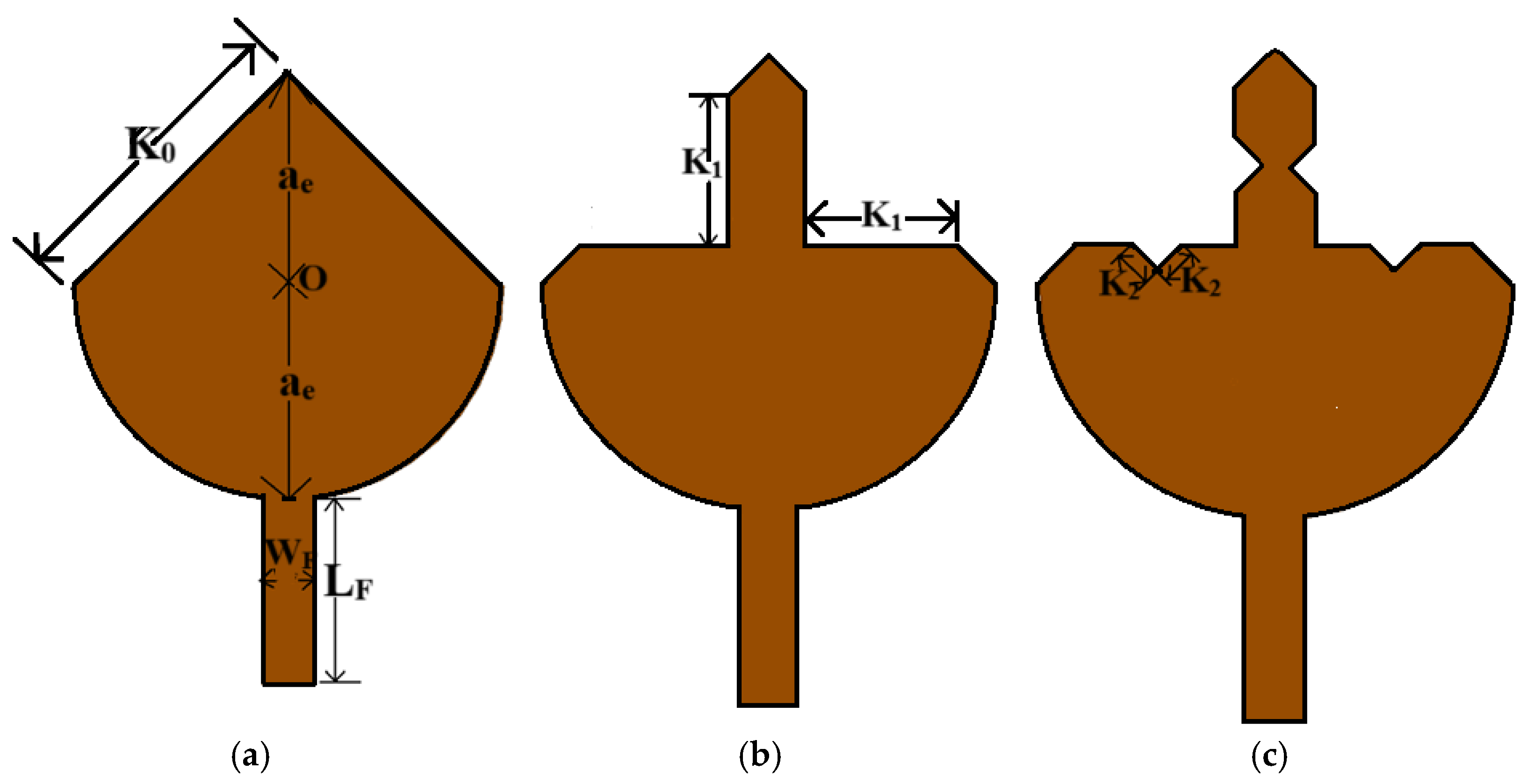
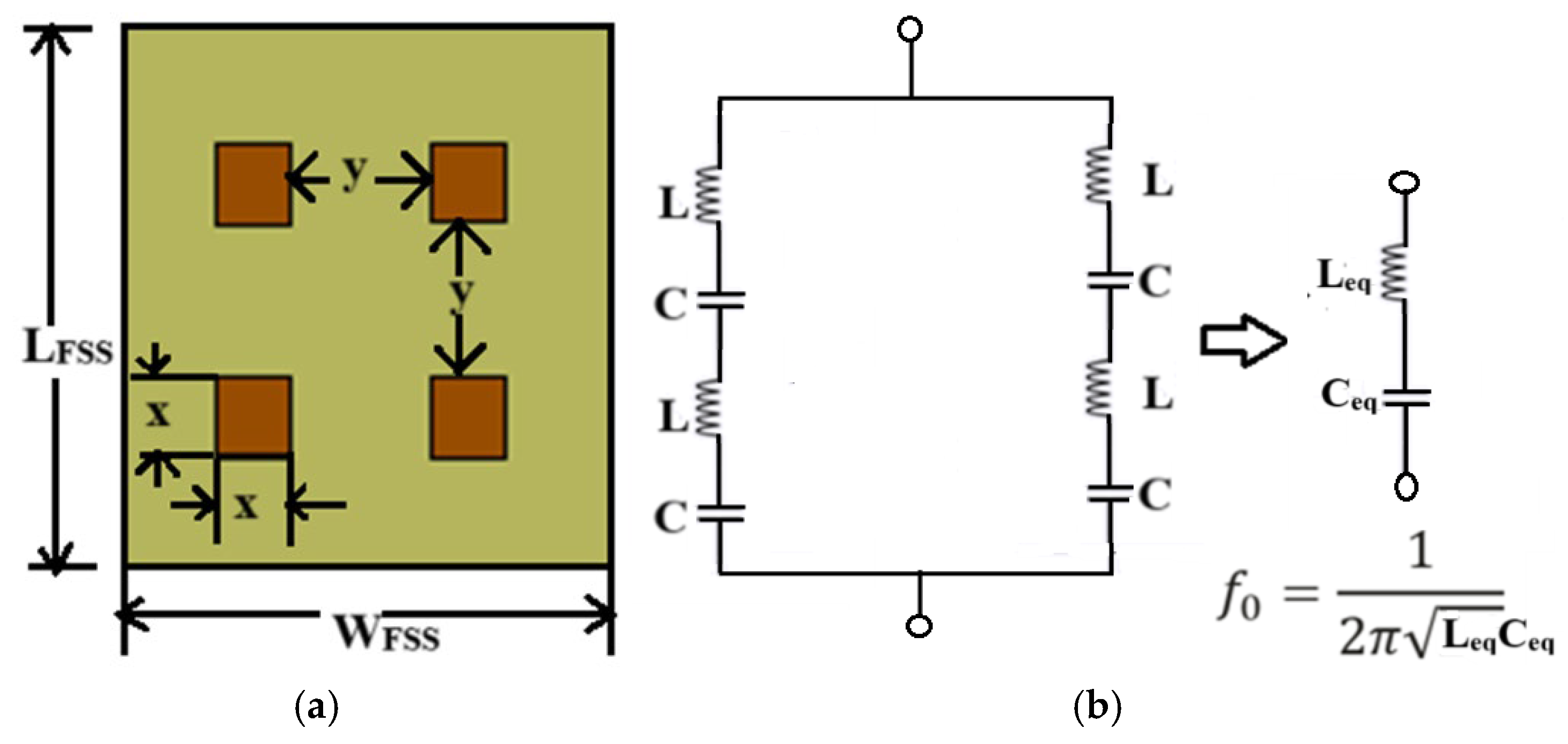
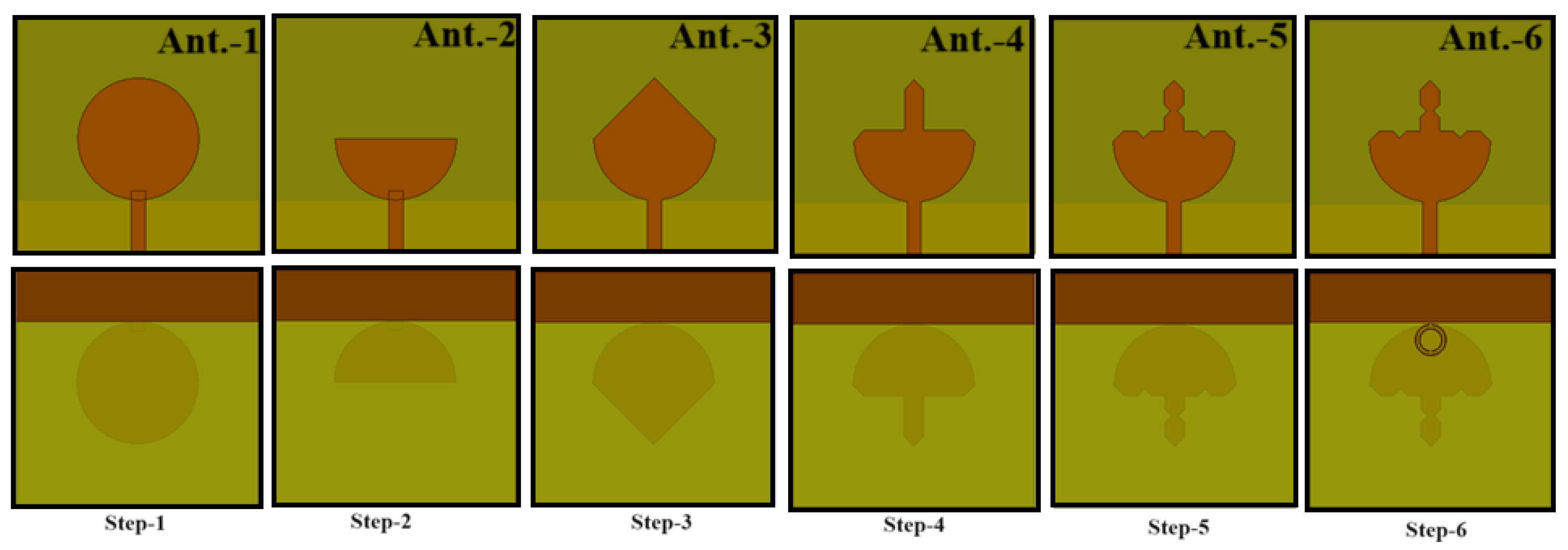
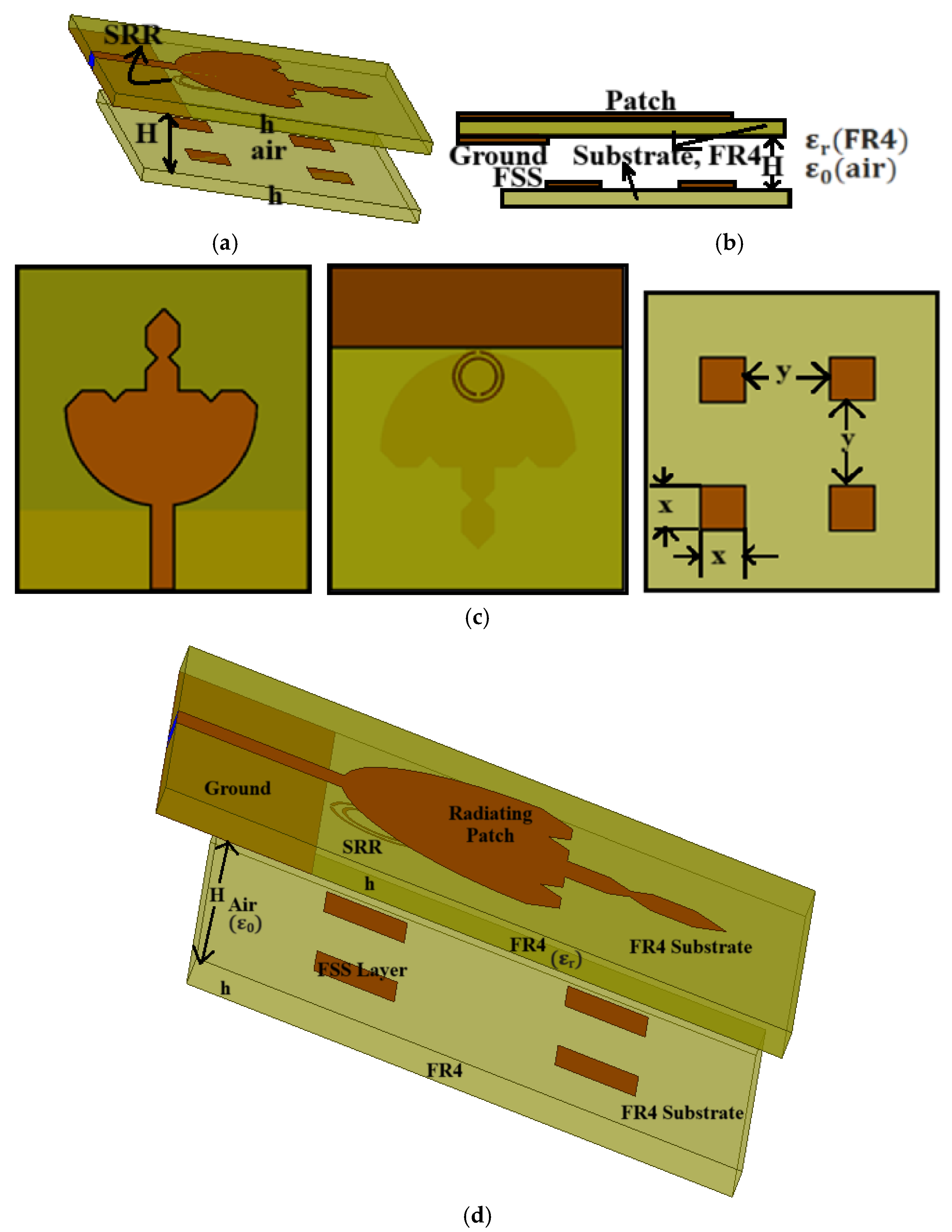

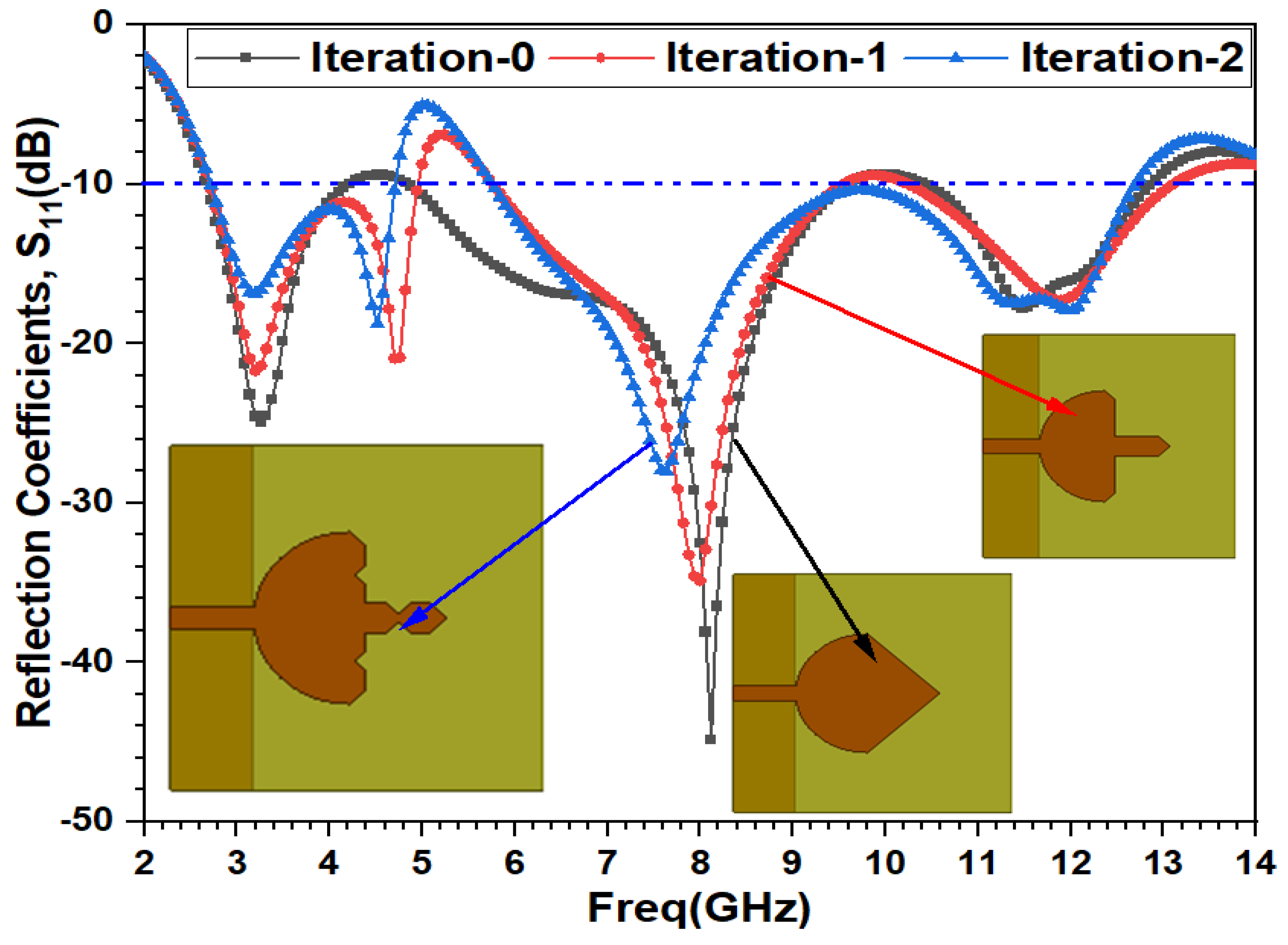

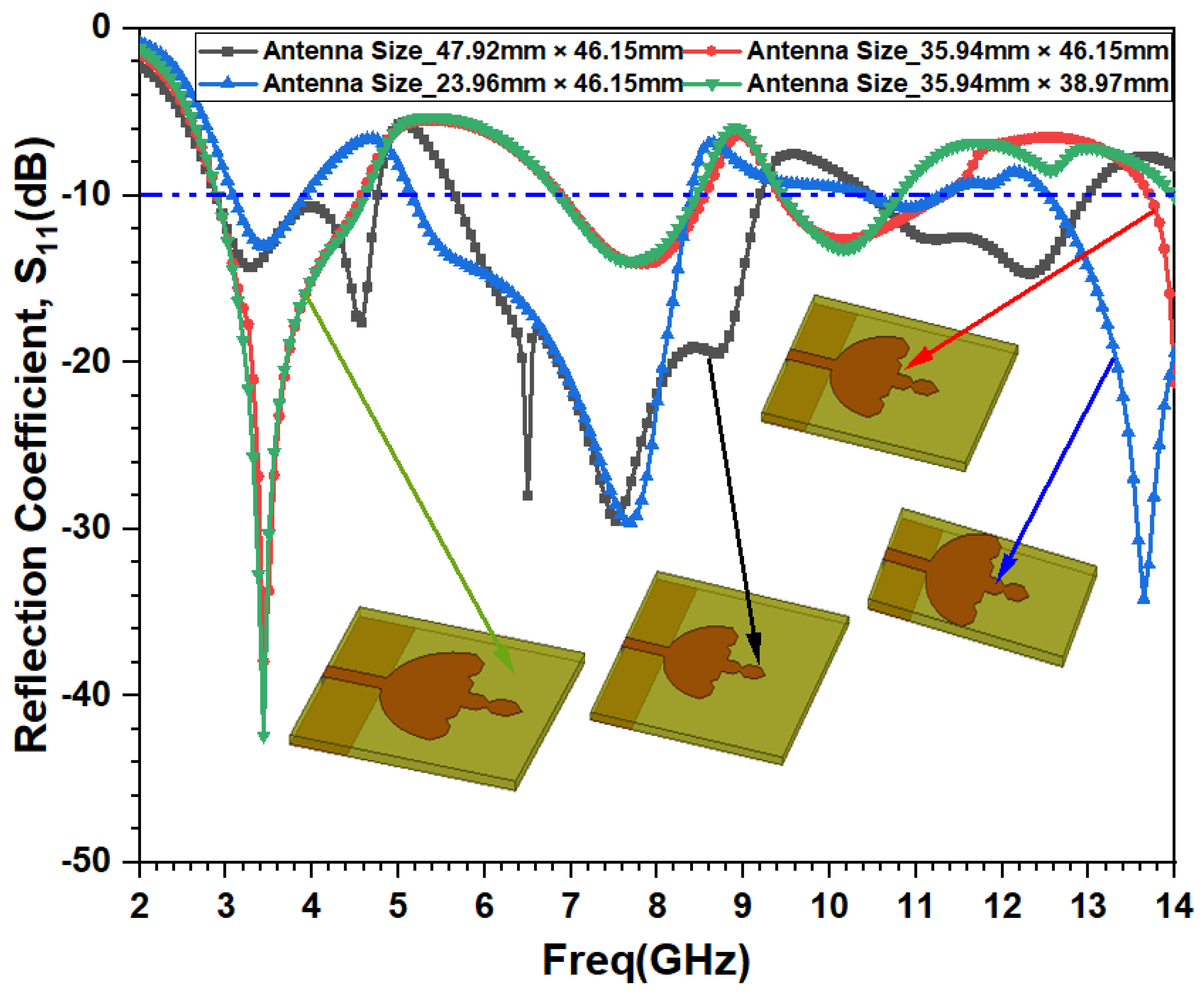
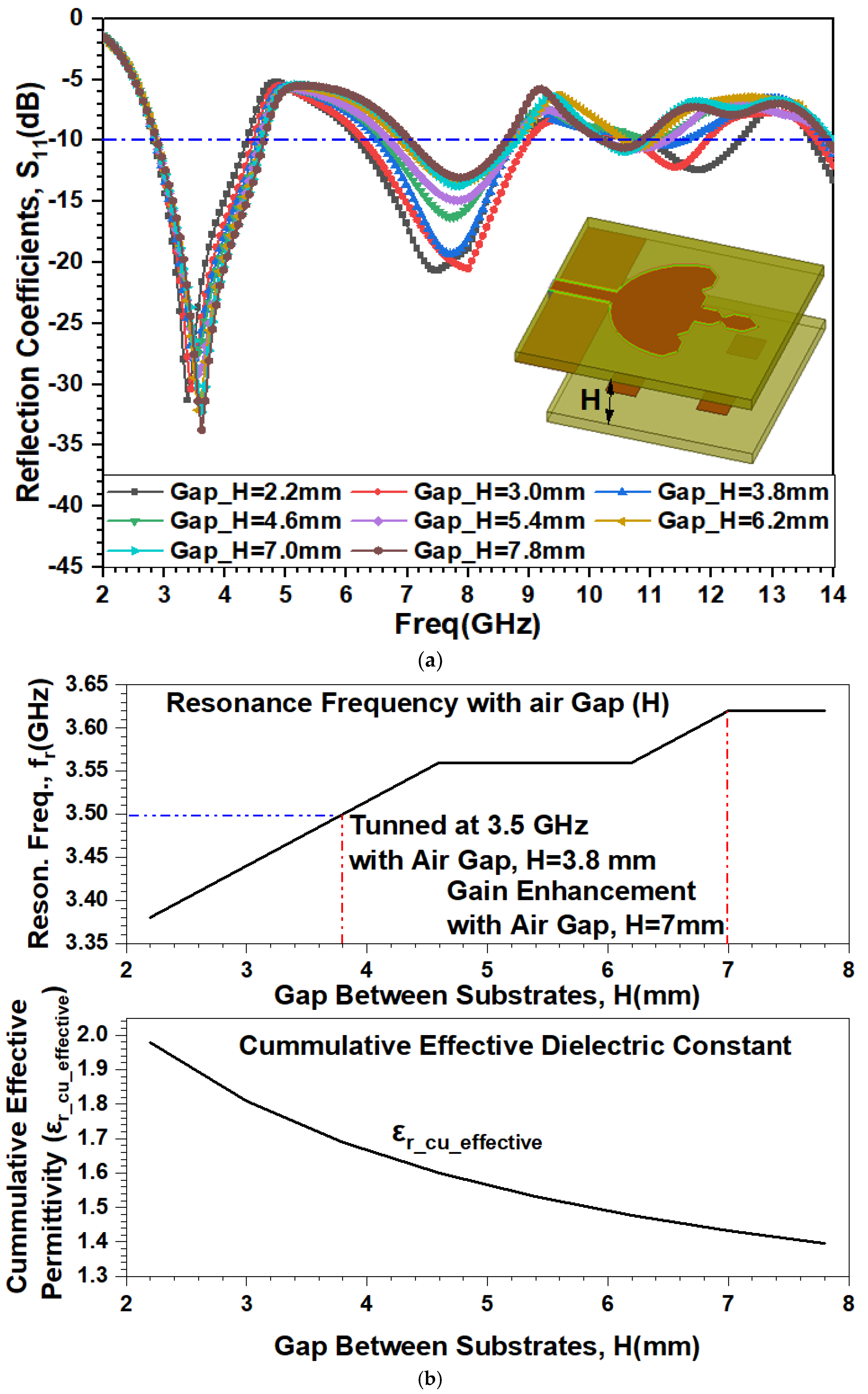

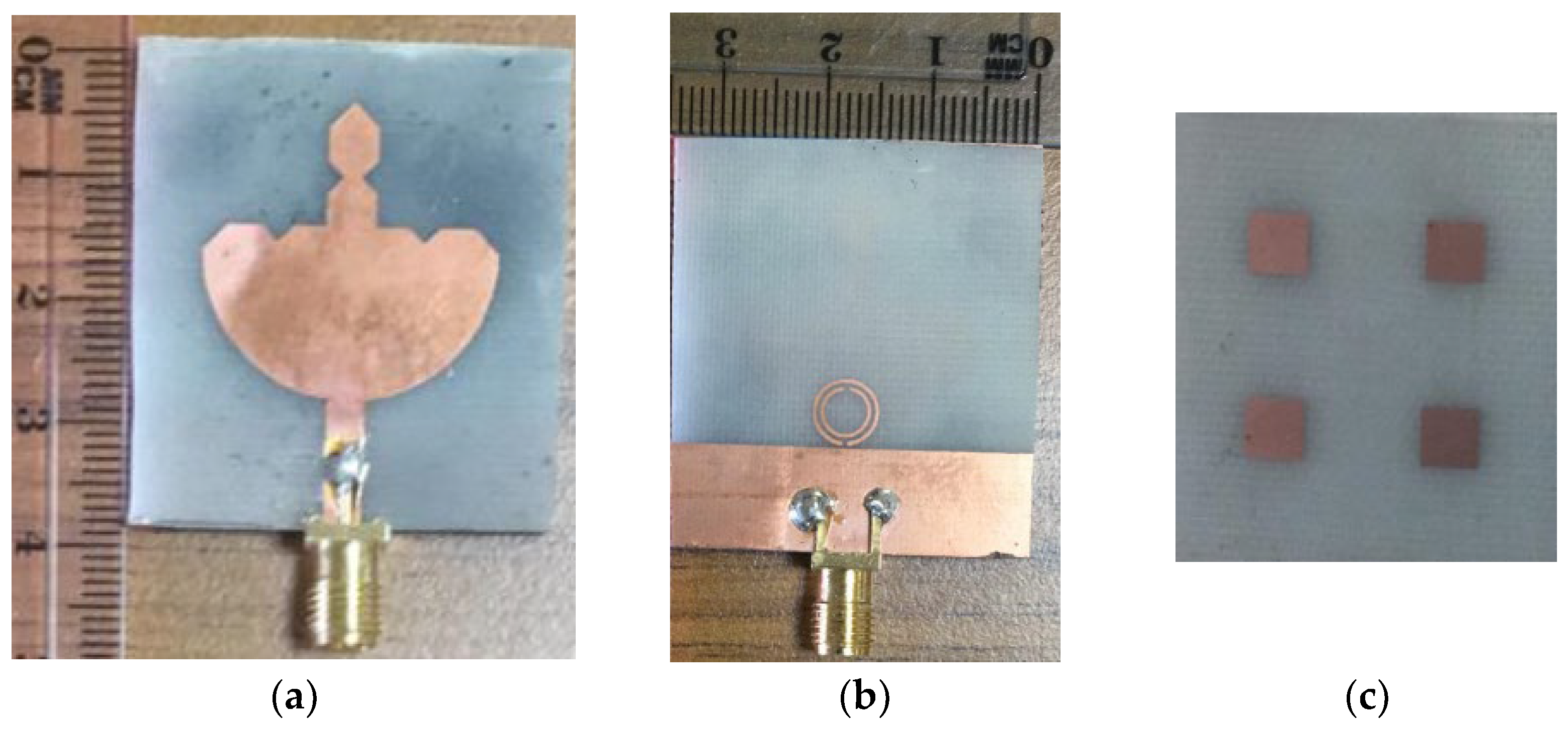
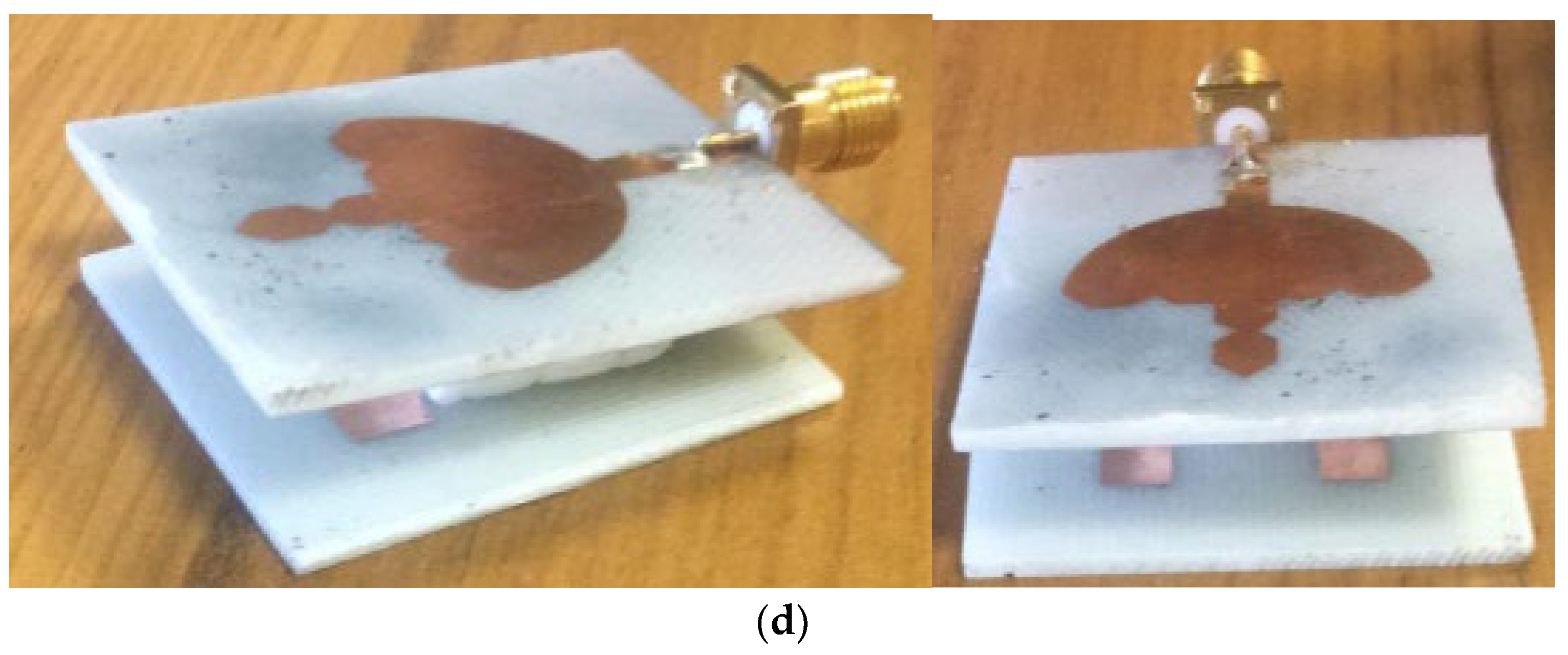
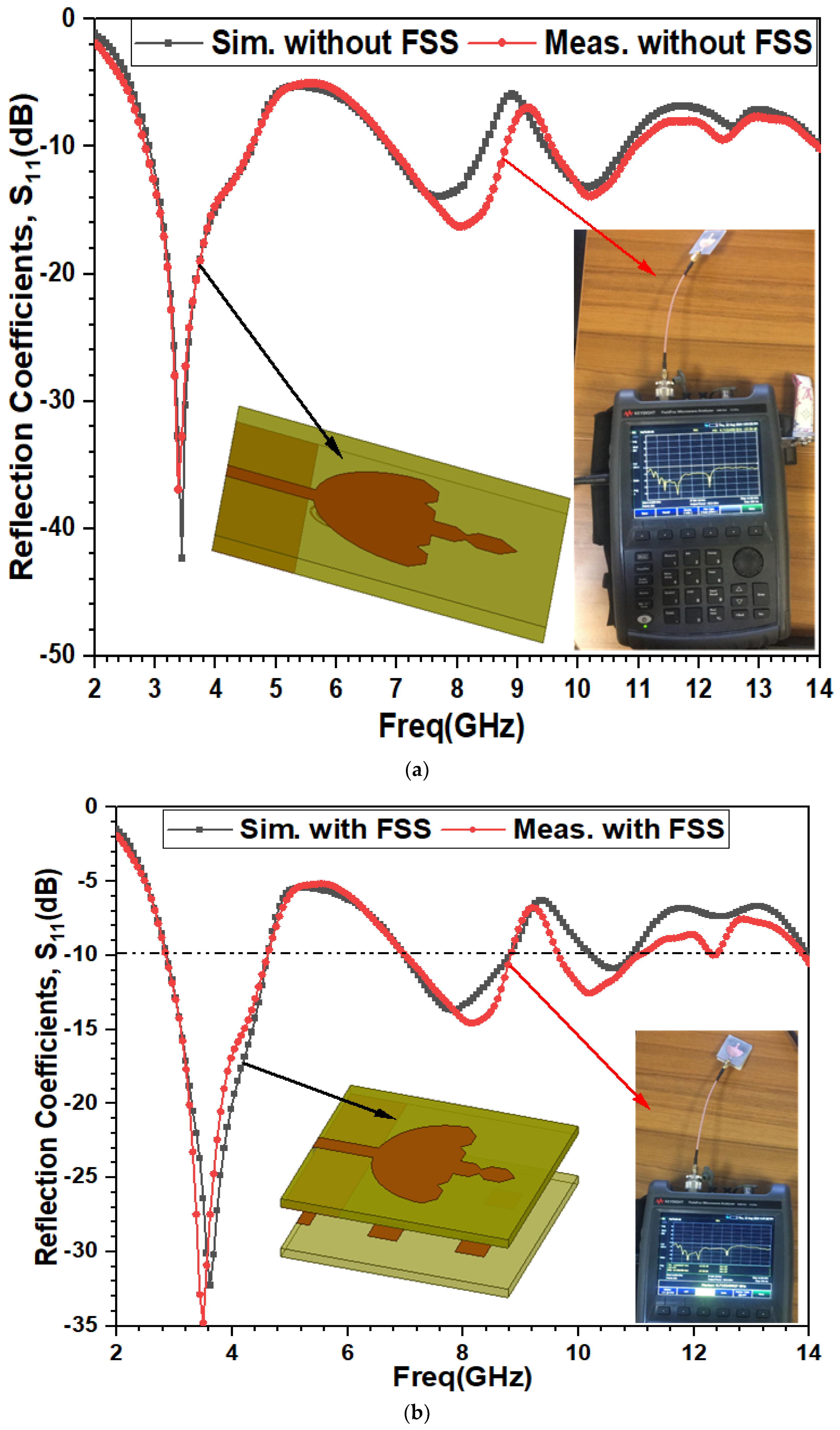

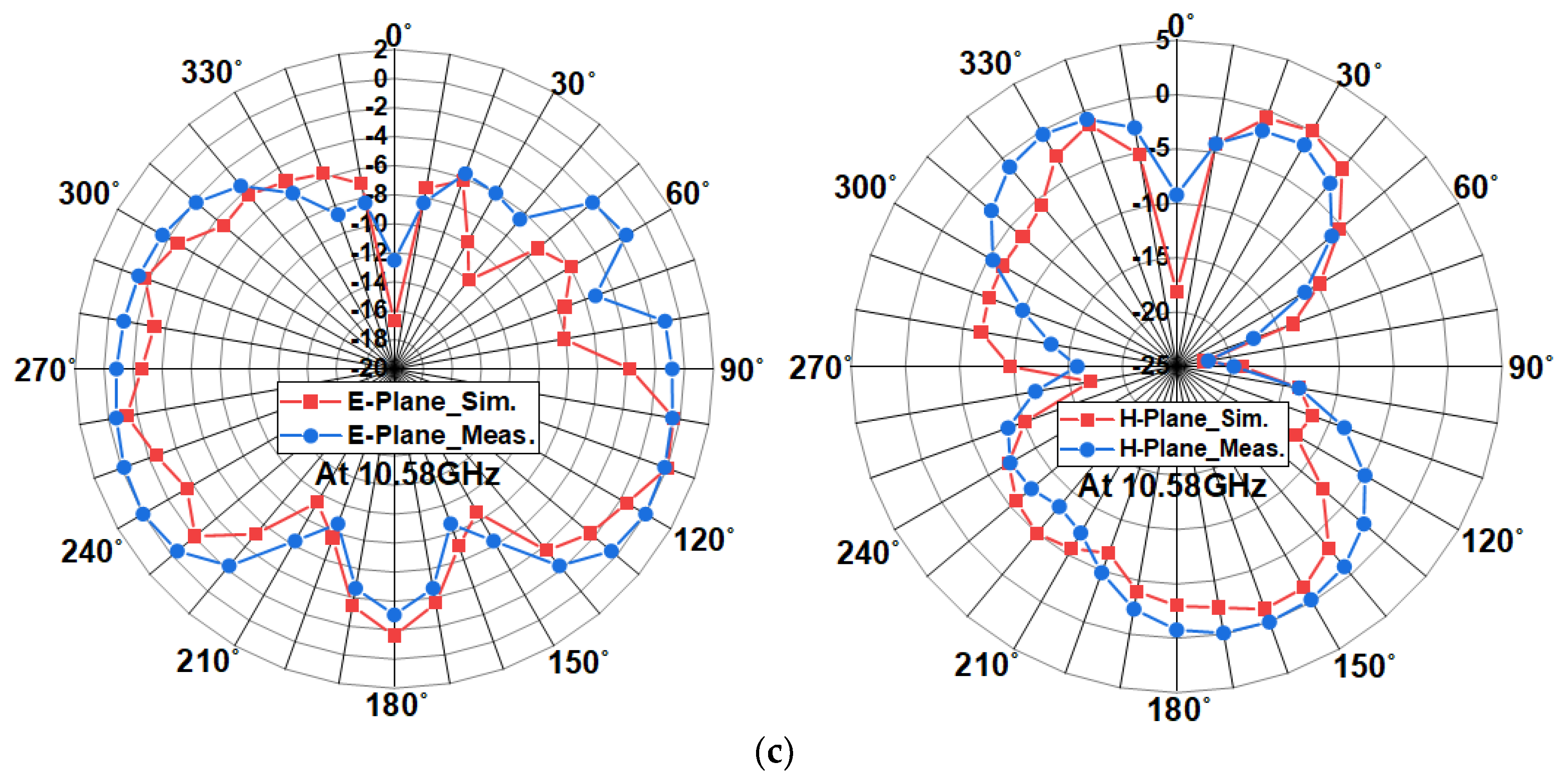
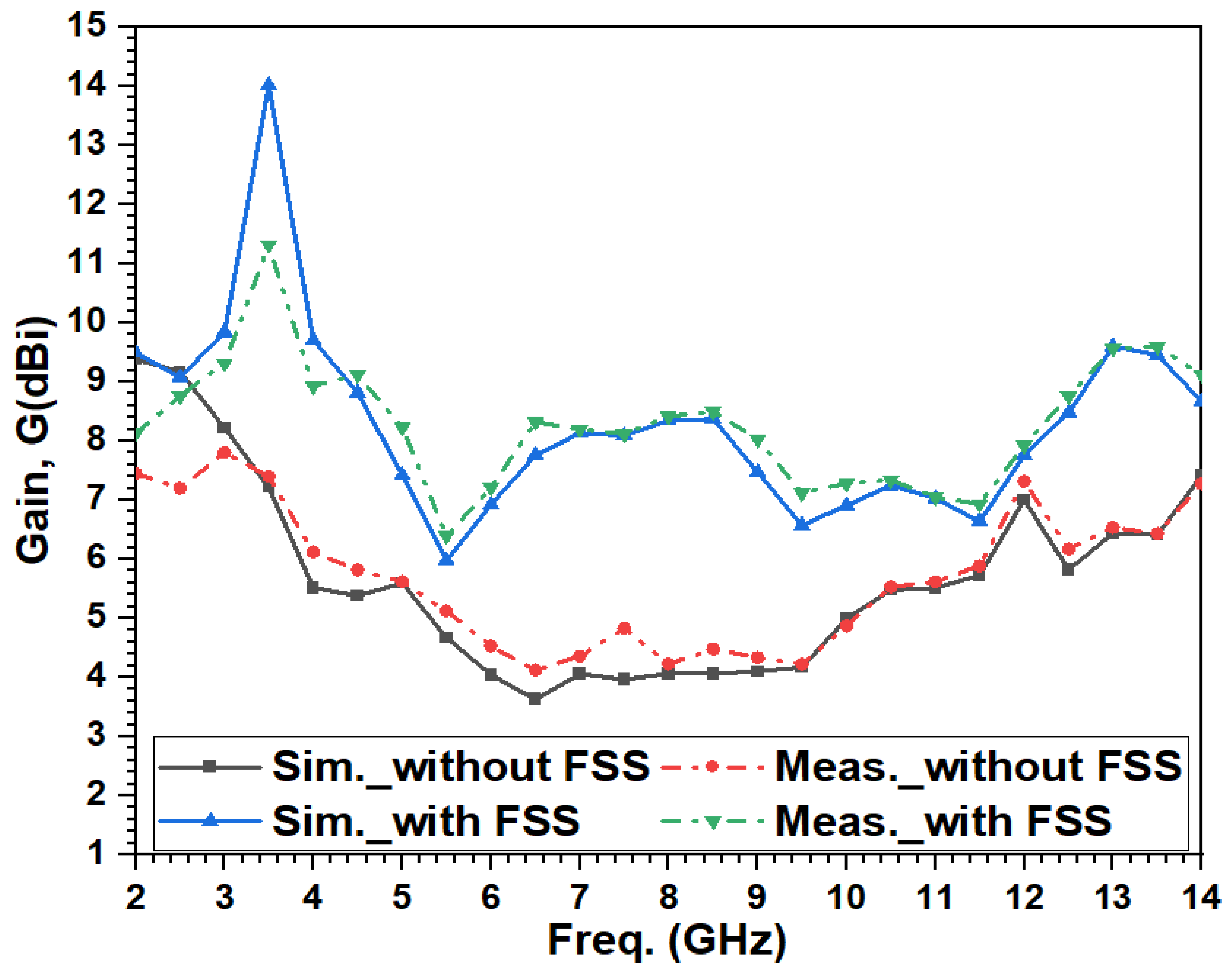

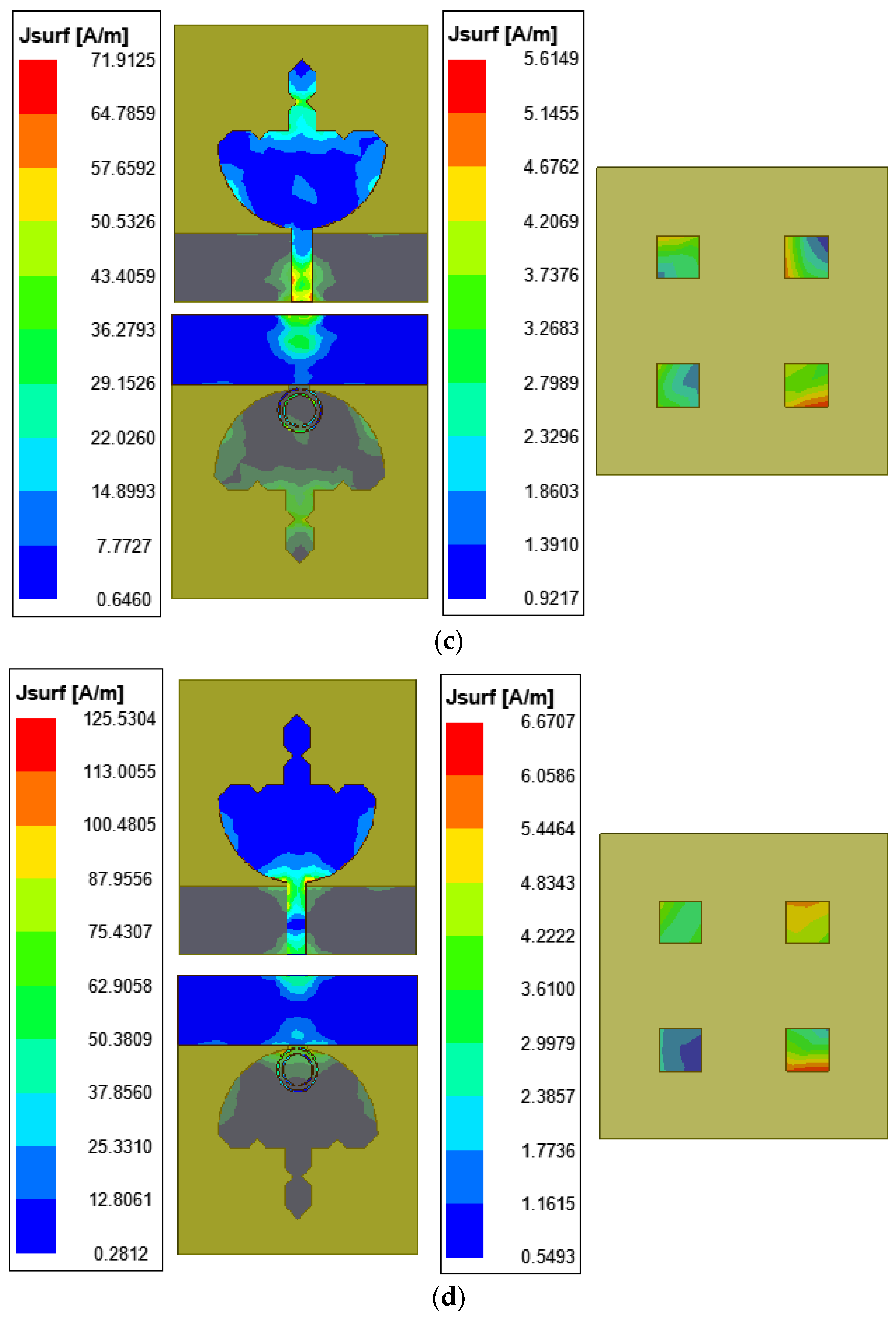

| Symbolic Designation | Description | Optimized Dimensions (mm) |
|---|---|---|
| WS | Substrate width | 35.94 |
| LS | Substrate length | 38.97 |
| ae | Patch radius | 11.98 |
| WF | Feed width | 3.0 |
| LF = | Feed length | 10.30 |
| WG | Ground width | 35.94 |
| LG | Ground length | 9.7 |
| Rout | Outer ring radius of SRR | 3.1 |
| Rin | Inner ring radius of SRR | 2.35 |
| g | SRR gap | 0.50 |
| W | SRR width | 0.25 |
| S | Gap between SRR rings | 0.28 |
| K | Koch curve dimension | 16.94 |
| K0 = | Iteration 0 | 16.94 |
| K1 = | Iteration 1 | 7.98 |
| K2 = | Iteration 2 | 1.882 |
| LFSS | Length of FSS | 33.96 |
| WFSS | Width of FSS | 35.94 |
| x | FSS square edge length | 5 |
| y | Gap between two squares of FSS | 10 |
| h | Height of substrates | 1.6 |
| H | Gap between substrates | 7.0 |
| Iteration | fr (GHz) | S11 (dB) | −10 dB BW (GHz) | Gain at fr (dBi) | Gain at 3.5 GHz (dBi) | Applications |
|---|---|---|---|---|---|---|
| Iteration 0 (modified circular patch) | 3.26 | −24.97 | 1.51 (2.67–4.18) | 21.92 | 8.36 | n77, n78, C-band and X-band |
| 8.12 | −44.82 | 4.68 (4.88–9.56) | 6.64 | |||
| 11.54 | −17.74 | 2.39 (10.46–12.85) | 9.30 | |||
| Iteration 1 | 3.20, 4.70 | −21.70, −20.92 | 2.24 (2.71–4.95) | 12.81, 10.58 | 12.37 | n77, n78, n79, C-band and X-band |
| 8.0 | −34.88 | 3.74 (5.78–9.52) | 6.0 | |||
| 11.90 | −17.28 | 2.80 (10.28–13.08) | 9.53 | |||
| Iteration 2 | 3.20, 4.52 | −16.84, −18.77 | 1.99 (2.72–4.71) | 12.08, 9.94 | 11.80 | n77, n78, n79, C-band and X-band |
| 7.64, 11.91 | −28.03, −17.78 | 6.95 (5.75–12.70) | 6.30, 9.57 |
| Case | Ground (mm) | fr (GHz) | S11 (dB) | −10 dB BW (GHz) | Gain (dBi) at fr | Gain (dBi) at 3.5 GHz |
|---|---|---|---|---|---|---|
| Iteration-2 antenna | Full ground (46.15 mm) | 9.50 | −21.13 | 0.43 (9.26–9.69) | 6.35 | 7.48 |
| Iteration-2 antenna | 50% ground (23.075 mm) | 9.56 | −11.09 | 0.38 (9.43–9.71) | 5.07 | 5.05 |
| 10.82 | −14.68 | 0.58 (10.54–11.12) | 14.24 | |||
| 13.58 | −12.64 | 1.04 (12.98–14.02) | 11.93 | |||
| Iteration-2 antenna | 11.98 | 3.26 | −13.74 | 0.52 (3.03–3.55) | 9.51 | 8.46 |
| 4.88 | −32.47 | 0.25 (4.77–5.02) | 8.59 | |||
| 8.66 | −14.41 | 0.97 (8.18–9.15) | 7.59 | |||
| 12.08 | −13.10 | 1.33 (11.39–12.72) | 9.44 | |||
| Iteration-2 antenna | 10.98 | 3.26 | −26.30 | 0.96 (2.84–3.80) | 12.89 | 12.36 |
| 4.76 | −14.93 | 0.31 (4.60–4.91) | 11.18 | |||
| 8.60 | −22.93 | 3.06 (6.30–9.36) | 7.05 | |||
| 12.20 | −16.72 | 2.22 (11.02–13.24) | 8.14 | |||
| Iteration-2 antenna | 10.21 | 3.20, 4.58 | −22.48, −14.96 | 2.04 (2.74–4.78) | 13.58, 9.58 | 12.22 |
| 8.18 | −39.87 | 3.68 (5.82–9.47) | 6.25 | |||
| 12.08 | −21.01 | 2.40 (10.42–12.82) | 10.55 | |||
| Iteration-2 antenna | 10.1 | 3.20, 4.58 | −24.64, −15.83 | 2.06 (2.69–4.75) | 13.09, 11.09 | 11.81 |
| 8.06 | −54.66 | 3.61 (5.82–9.43) | 6.29 | |||
| 12.08 | −20.54 | 2.48 (10.37–12.85) | 10.71 | |||
| Iteration-2 antenna + SRR | 10.1 | 3.26 | −25.84 | 1.27 (2.75–4.02) | 10.72 | 10.08 |
| 4.70 | −16.50 | 0.49 (4.36–4.85) | 10.29 | |||
| 6.92 | −13.08 | 2.26 (5.91–8.17) | 5.98 | |||
| 12.14 | −14.52 | 2.38 (10.29–12.67) | 8.31 | |||
| Iteration-2 antenna + SRR | 9.7 | 3.26, 4.58 | −14.34, −17.66 | 1.89 (2.89–4.76) | 16.66, 9.06 | 15.11 |
| 6.50, 7.52 | −27.98, −29.50 | 3.55 (5.65–9.20) | 12.67, 5.84 | |||
| 12.32 | −14.74 | 2.53 (10.47–13.0) | 8.55 |
| Miniaturization | Antenna Size (mm2) WS × LS | fr (GHz) | S11 (dB) | −10 dB BW (GHz) | Gain (dBi) at fr | Gain at 3.5 GHz (dBi) |
|---|---|---|---|---|---|---|
| Primary antenna WS = 4ae = 47.92 mm LS = LF + 3ae = 46.15 mm | 47.92 × 46.15 | 3.26, 4.58 | −14.34, −17.66 | 1.87 (2.89–4.76) | 16.66, 9.06 | 15.11 |
| 6.50, 7.52 | −27.98, −29.50 | 3.55 (5.65–9.20) | 12.67, 5.84 | |||
| 12.32 | −14.74 | 2.53 (10.47–13.0) | 8.55 | |||
| Reduced width WS = 3ae = 35.94 mm LS = LF + 3ae = 46.15 mm | 35.94 × 46.15 | 3.44 | −37.92 | 1.68 (2.90–4.58) | 12.92 | 11.96 |
| 7.82 | −14.08 | 1.66 (6.89–8.55) | 6.25 | |||
| 10.16 | −12.63 | 1.88 (9.43–11.31) | 8.05 | |||
| Reduced width WS = 2ae = 23.96 mm LS = LF + 3ae = 46.15 mm | 23.96 × 46.15 | 3.44 | −13.02 | 0.84 (3.08–3.92) | 10.97 | 11.02 |
| 7.70 | −26.61 | 3.23 (5.16–8.39) | 5.99 | |||
| 10.88 | −10.74 | 0.85 (10.44–11.29) | 7.83 | |||
| 13.64 | −34.64 | 1.58 (12.52–14.10) | 9.85 | |||
| Miniaturized antenna WS = 3ae = 35.94 mm LS = LF + 2ae + 3h = 38.97 mm | 35.94 × 38.97 | 3.44 | −42.37 | 1.71 (2.90–4.61) | 9.52 | 9.37 |
| 7.70 | −13.96 | 1.59 (6.86–8.45) | 6.15 | |||
| 10.16 | −13.21 | 1.33 (9.47–10.80) | 7.41 |
| FSS Loading | Gap (H) between Substrates | fr (GHz) | S11 (dB) | −10 dB BW (GHz) | Gain (dBi) at fr | Gain at 3.5 GHz (dBi) |
|---|---|---|---|---|---|---|
| Parent antenna with FSS below the radiator (distance between radiator and FSS = 3.0 mm) | H = 2.2 mm | 3.38 | −31.32 | 2.84–4.36 | 10.29 | 10.46 |
| 7.46 | −20.65 | 6.20–8.78 | 8.59 | |||
| 11.78 | −12.43 | 10.93–12.48 | 8.39 | |||
| Parent antenna with FSS below the radiator (distance between radiator and FSS = 4.6 mm) | H = 3.0 mm | 3.44 | −30.36 | 2.85–4.47 | 8.43 | 8.31 |
| 8.0 | −20.52 | 6.28–8.99 | 8.59 | |||
| 11.42 | −12.17 | 10.70–11.93 | 6.40 | |||
| Primary antenna with FSS below the radiator (distance between radiator and FSS = 5.4 mm) | H = 3.8 mm | 3.50 | −27.85 | 2.86–4.53 | 7.14 | 7.14 (tuned) |
| 7.70 | −19.31 | 6.51–8.74 | 8.47 | |||
| 11.18 | −10.44 | 10.78–11.56 | 6.53 | |||
| Primary antenna with FSS below the radiator (distance between radiator and FSS = 6.2 mm) | H = 4.6 mm | 3.56 | −27.49 | 2.87–4.58 | 6.93 | 7.08 |
| 7.70 | −16.26 | 6.62–8.71 | 8.53 | |||
| Primary antenna with FSS below the radiator (distance between radiator and FSS = 7.0 mm) | H = 5.4 mm | 3.56 | −29.15 | 2.86–4.58 | 7.93 | 7.87 |
| 7.76 | −14.91 | 6.71–8.77 | 8.31 | |||
| 10.76 | −10.66 | 10.22–11.25 | 7.91 | |||
| Primary antenna with FSS below the radiator (distance between radiator and FSS = 7.8 mm) | H = 6.2 mm | 3.56 | −32.11 | 2.89–4.61 | 8.12 | 8.19 |
| 7.82 | −13.48 | 6.89–8.77 | 8.03 | |||
| 10.82 | −10.51 | 10.56–11.04 | 8.0 | |||
| Primary antenna with FSS below the radiator (distance between radiator and FSS = 8.6 mm) | H = 7.0 mm | 3.62 | −32.29 | 2.87–4.62 | 11.37 | 14.02 (Gain Enhan.) |
| 7.82 | −13.75 | 6.99–8.81 | 8.21 | |||
| 10.58 | −10.90 | 10.22–10.92 | 7.20 | |||
| Parent antenna with FSS below the radiator (distance between radiator and FSS = 9.4 mm) | H = 7.8 mm | 3.62 | −33.74 | 2.88–4.64 | 8.27 | 8.49 |
| 7.88 | −13.04 | 7.04–8.63 | 8.08 | |||
| 10.52 | −11.88 | 10.20–10.86 | 8.45 |
| Case | Ground Length (mm) | fr (GHz) | S11 (dB) | −10 dB BW (GHz) | Gain (dBi) at fr | Gain (dBi) at 3.5 GHz |
|---|---|---|---|---|---|---|
| Antenna without SRR without FSS (35.94 × 38.97 mm2) | 9.7 | 3.44 | −33.14 | 1.69 (2.91–4.60) | 13.50 | 13.38 |
| 8.48 | −31.03 | 4.02 (6.92–10.94) | 6.51 | |||
| Antenna with SRR without FSS (35.94 × 38.97 mm2) | 9.7 | 3.44 | −42.37 | 1.71 (2.90–4.61) | 9.52 | 9.37 |
| 7.70 | −13.96 | 1.59 (6.86–8.45) | 6.15 | |||
| 10.16 | −13.21 | 1.33 (9.47–10.80) | 7.41 | |||
| Antenna with SRR + FSS (35.94 × 38.97 mm2) | 9.7 (FSS size 35.94 × 33.96 mm2 Gap, H = 7.0 mm) | 3.62 | −32.29 | 1.75 (2.87–4.62) | 11.37 | 14.02 (Gain Enhancement) |
| 7.82 | −13.75 | 1.81 (6.99–8.81) | 8.21 | |||
| 10.58 | −10.90 | 0.70 (10.22–10.92) | 7.20 |
| Ref. [Year] | fr (GHz) | Antenna Size (mm3) | M | UC and FSS Size (mm3) | H (mm) | f0 (GHz) | BW fL–fH (GHz) | GEnhan. (dBi) | Cost |
|---|---|---|---|---|---|---|---|---|---|
| [40] Kushwaha and Kumar, 2016 | 3.425, 8.94 | 45 × 50 × 1.6 | −51.67% (size increased) | 23 × 23 × 1.6 (UC) 150 × 150 × 1.6 (FSS) | 25 | 3.5 | 2.2–4.8 | 3–4 | Low |
| [41] Devarapalli et al., 2023 | 3, 8.75 | 44 × 40 × 1.6 | −33.78% (size increased) | 4.5 × 4.5 (UC) 44 × 40 × 1.6 (FSS) | NA | 3.5 | 2.49–4.36, 7.96–9.92 | 6.15 to 9.48 | Low |
| [42] Chen, and Tao, 2011 | 2.45, 5.8 | 30 × 54 × 4.4 | −242.1% (size increased) | 32 × 32 × 2.8 (UC) 96 × 64 × 3.2 (FSS) | 4.4 | 2–6G | 2.38–2.73 3.28- 5.8 | 4.69, 5.64 | Low |
| [43] Sah et al. 2019 | 3.53, 6.2 | 105 × 175 × 1.6 | −1661.95% (size increased) | 15 × 25 × 1.6 (UC) 105 × 175 × 1.6 (FSS) | 49 | 3.5 | 3.48–3.65 5.75–6.37 | 13.3, 13.90 | Low |
| [44] Peddakrishna and Khan, 2018 | 5.2 | 50 × 50 × 1.6 | −144.14% (size increased) | 7.02 × 7.02 × 1.6 (UC) 50 × 50 × 1.6 (FSS) | 28.5 | 5.38 | 5.07–5.56 | 2.5 to 5.1 | Low |
| [45] Zhu et al., 2014 | 5.6 | 106 × 106 × 1.6 | 0% (not miniaturized) | 24 × 24 × 1.6 (UC) 106 × 106 × 1.6 (FSS) | 33 | 5.5 | 5.3–6.3 | 4.7 to 9.8 | Low |
| [46] Bouslama et al., 2016 | 5.8 | 140 × 140 × 1.57 | 0% (not miniaturized) | 46.5 × 46.5 × 0.127 (UC) 140 × 140 × 0.127 (FSS) | 25 (above patch) | 6.0 | 5.7–6.2 | 5.3 to 12.0 | High |
| [47] Anand and Nath, 2024 | 6.0, 9.05, 11.56 | 21.13 × 24.81 × 1.6 | −35.36% (size increased) | 21.13 × 24.81 × 1.6 (CFSS) | 6.4 (below patch) | 6.0 | 6.43–6.72 8.85–9.33 10.5–13.22 | 5.25 to 8.49 | Low |
| [48] Anand and Nath, 2024 | 4.04, 5.76, 7.64 | 16.8 × 26.72 × 1.6 | 0% (not miniaturized) | 32.2 × 26.72 × 1.6(FSS) | 2.0 (above patch) | 5.0 | 3.56–4.63, 5.17–6.22, 6.74–8.22 | 4.22 to 8.98 | Low |
| [49] Ara and Nuna, 2024 | 5.5 | 49 × 49 × 1.588 | −109.13% (size increased) | 49 × 49 × 1.588 (FSS) | 5.0 (below patch) | 5.8 | 3.91–6.44 | 4.41 to 8.99 | Medium |
| [50] Jing et al. 2023 | 5.89 | 50 × 28 × 0.1 Polyimide (PI)substrate | 0% (not miniaturized) | 102 × 102 × 1.588 (FSS) | 40 (below patch) | 2.4 | 2.18–2.90 | 3 to 8.31 | Medium |
| [51] Ara and Nuna, 2023 | 5.89 | 49 × 49 × 1.588 | −83.2% (size increased) | 49 × 49 × 1.588 (FSS) | 6.4 (below patch) | 5.8 | 3.91–6.44 | 2.87 to 7.76 | Medium |
| Proposed Work | 3.62 7.82 10.58 | 35.94 × 38.97 × 1.6 | Miniaturized (36.67%) | 5 × 5 (UC) 35.94 × 33.96 × 1.6 (FSS) | 7.0 (below patch) | 3.5 | 2.87–4.62 6.99–8.81 10.22–10.92 | 9.37 to 14.02 | Low |
Disclaimer/Publisher’s Note: The statements, opinions and data contained in all publications are solely those of the individual author(s) and contributor(s) and not of MDPI and/or the editor(s). MDPI and/or the editor(s) disclaim responsibility for any injury to people or property resulting from any ideas, methods, instructions or products referred to in the content. |
© 2024 by the authors. Licensee MDPI, Basel, Switzerland. This article is an open access article distributed under the terms and conditions of the Creative Commons Attribution (CC BY) license (https://creativecommons.org/licenses/by/4.0/).
Share and Cite
Varshney, A.; Gençoğlan, D.N. High-Gain Multi-Band Koch Fractal FSS Antenna for Sub-6 GHz Applications. Appl. Sci. 2024, 14, 9022. https://doi.org/10.3390/app14199022
Varshney A, Gençoğlan DN. High-Gain Multi-Band Koch Fractal FSS Antenna for Sub-6 GHz Applications. Applied Sciences. 2024; 14(19):9022. https://doi.org/10.3390/app14199022
Chicago/Turabian StyleVarshney, Atul, and Duygu Nazan Gençoğlan. 2024. "High-Gain Multi-Band Koch Fractal FSS Antenna for Sub-6 GHz Applications" Applied Sciences 14, no. 19: 9022. https://doi.org/10.3390/app14199022








